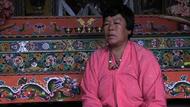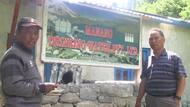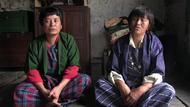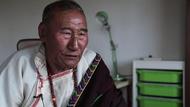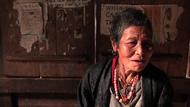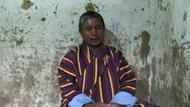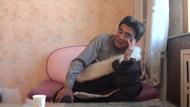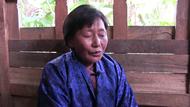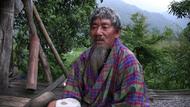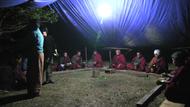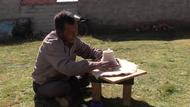Video Overview
A resident monk provides an overview of the history of Meru Nyingpa and its protective deities.
- Meru Nyingpa
- དགེ་འདུན་པ་ Monkརྨེ་རུ་དགོན་པ་འདི་ལྟ་གནས་ཆུང་གི་ཡན་ལག་བྱས་འོ་འདི་འདྲས་སེ་རེད། གནས་ཆུང་ཡན་ཡག་བྱས། དེ་གཙོ་བོ་ར་དེ་ལྟ་གནས་ཆུང་བྱས་ནས་འདུག་སེ།Meru Monastery is a part of Nechung Monastery, which is the main monastery.
- ཨཱ་ནི་དགོན་པ་ལྟ་ཞིབ་ཚགས་པོ་འདའི་གྲ་རྒྱས་པོ་ཞུ་ཡག་སེ་མི་འདུག ང་གཅིག་དང་གཉིས་ངེས་ཀྱི་མི་འདུག་ལྟ། ལྟ་ང་རང་ཚོ་ལའི་མར་སྐུ་ཤོག་བགྲེས་པ་རིམ་བྱོན་གྱིས་མར་བཀའ་སློབ་ར་པོ་ཚིག་རེ་ཙམ་གཉིས་ཙམ་དེ་འདྲས་གནང་ཙང་འདི་མར་འོ་དེ་འདྲས་སེ་རེད་ཟེར་ཞུ་ར་ཅིགI don't know the detailed history of this monastery as I can't remember everything. What I am going to share now is also what I had heard from my elder generations.
- ཨཱ་ནི་མ་ཤེས་པ་ཡིན་ན་ད་ག་རང་རེད། དེ་སོང་ཙང་ལྟ་གཙོ་བོ་གནས་ཆུང་དགོན་པ་དེ་ལྟ་རྟེན་གཙོ་གཙོ་བོ་གང་རེད་ཟེར་ན། ལྟ་གཙོ་བ་ར་དེ་གུ་རུ་རིན་པོ་ཆེའི། ལྟ་ས་དགེ་རྙིང་གསུམ་གྱི་རེད། ཆོས་ལུགས་བྱས་ན་ས་དགེ་རྙིང་གསུམ། ས་སྐྱ། དགེ་ལུགས་པ། རྙིང་མ། འོ་འདུག་སེ་རེད།If I don't know something, then there is nothing I can do about it. The main statue at Nechung Monastery is that of Guru Rinpoché. In term religious schools, it is for Sakya, Geluk, and Nyingma schools.
- འོ་འདིའི་ནང་ནས་ལྷ་གཙོ་བོ་ར་དེ་གང་རེད་ཟེར་ན་འམ། གུ་རུ་རིན་པོ་ཆེན་ང་ཚོའི་ལྟ་ཡིད་དམ་ཟེར་ན་ག་རེ་ཟེར་ནའི་ལྟ་བླ་མའི་ཟེར་ནའི་གུ་རུ་རིན་པོ་ཆེ་རེད། འདིའི་བསྟན་སྲུང་དེ་ག་རེད་ཟེར་ན་གནས་ཆུང་ཆོས་སྐྱོང་།The chief god [Buddha] is Guru Rinpoché. And we can say he is our sacred deity or master. He is everything. Then Nechung Chökyong is the main protector deity of the monastery.
- གནས་ཆུང་ཆོས་སྐྱོང་དེ་ད་ལྟ་འབྱུང་ཁུངས་དེ་ལྟ་རོབ་ཙམ་ར་ཞུས་པ་ཡིན་ན་གཙོ་བོ། འམ་ཁོ་རང་དང་པོ་གནས་ཆུང་ལ་ཕེབས་ཡག་དེ་ད་ལྟ་དང་པོ་དང་པོ་དེ་བསམ་ཡས་ལ་འདི་འདྲས་སེ་བྱུང་བྱས།Now I will give a brief account on the origin of the Nechung Chökyong. He first appeared in Samyé.
- བསམ་ཡས་ལ་གང་འདྲས་སེ་བྱུང་ཟེར་ན། བསམ་ཡས་གཙུག་ལག་ཁང་དེ་ནས་དེ་བཞེངས་པའི་སྐབས་ལ་རྒྱལ་པོ་ཁྲི་སྲོང་ལྡེ་བཙན་དང་ཆོས་རྗེ། ཆོས་རྒྱལ་རྣམ་པ་ཚོ་དེ་ནས་འདི་འདྲས་སེ་གཙོ་བོ་རྒྱལ་པོ་ཁྲི་སྲོང་ལྡེ་བཙན། དེ་ནས་ཆོས་རྒྱལ་རྣམ་པ་གང་ལ་བསམ་ཡས་བཞེངས་ཚར་ནས་བསམ་ཡས་ལ་རྟེན་གཙོ་ཞིག་དགོས་ཀྱིས་ཟེར་བཀའ་སློབ་གནང་།At that time, led by King Trisong Detsen, the king and his minister were constructing the Samyé Monastery at the time. After its completion, they felt the need for a sacred deity protect it.
- རྟེན་གཙོ་དེ། བསྟན་སྲུང་ཞིག་དགོས་ཀྱིས་གསུངས་གནང་ནས་བསྟན་སྲུང་འདིའི་ནང་གཙོ་བོ་གནས་ཆུང་ཆོས་སྐྱོང་དེ་བྷ་ཏ་ཧོར་ནས་སྤྱན་གདན་དྲངས་བྱས་གདན་འདྲེན་ཞུས།They said that they need a guardian of Buddha dharma. So Nechung Chökyong was brought to Samyé from Bhatahor.
- ལྟ་བྷ་ཏ་ཧོར་ལ་དེའི་སྐབས་ལ་བྷ་ཏ་ཧོར་ཟེར་ཡག་འདའི་ལྟ་འདི་གཅིག་འདི་བྷ་ཏ་ཧོར་ཡིན་ན་གནས་ཚུལ་གཅིག་གཉིས་ཙམ་ཞུ་ཡག་མི་འདུག འདི་འདྲས་སེ་གསུང་རྒྱུན་ལ་བྷ་ཏ་ཧོར་ནས་རེད་ཟེར་དེ་འདྲས་སེ་བཀའ་སློབ་གནང་།As for the place Bhatahor, I don't know much about it except I heard that Nechung originally came from that place.
- ཨཱ་ནི་བྷ་ཏ་ཧོར་ནས་གུ་རུ་རིན་པོ་ཆེ་ཡིས་མར་བསམ་ཡས་བཞེངས་ཚར་ནས་བསམ་ཡས་ཀྱི་བསྟན་སྲུང་ལ་སྤྱན་དྲངས་བྱས་བྱས་འདུག་སེ་གནང་།After completion of the Samyé Monastery, Guru Rinpoché brought Nechung from Bhatahor as its chief guardian of Buddha dharma.
- བསམ་ཡས་ལ་གཙུག་ལག་ཁང་བཞེངས་པའི་རྗེས་ལ་དེ་དང་པོ་ཡིན་ན། འོ་འདི་རྒྱལ་པོ་ཁྲི་སྲོང་ལྡེ་བཙན་ལྟ་དེ་ཚོས་གུ་རུ་རིན་པོ་ཆེ་གི་འདི་གས་ལྷ་འདྲེ་ཚང་མ་དམ་ལ་བཏག་པའི་སྒང་ལ་དེ་ནས་གནས་ཆུང་རྡོ་རྗེ་གྲགས་ལྡན་དེ་གཞན་དང་མི་འདྲ་བའི་ཁག་པོ་གནང་བྱས།At the time of construction of the Samyé monastery, Guru Rinpoché was binding all the local gods and demons under oath. Among them, Nechung Dorjé Drakden [Nechung Chökyong] proved to extremely difficult to tame.
- ཨཱ་ནི་རྗེས་ལ་ཡ་ཁོ་རང་བསམ་ཡས་ལ་འདྲ་བཞིན་པའི་རྟེན་དོད། རྟེན་གྱི་ཁོ་རང་རྟེན་གྱི་འདི་གཅིག་དོད་བཞེངས་པ་གནང་། དོད་འདི་ལ་འདི་སེམས་སང་མ་སོང་ནའི་ད་གར་ཆགས་ནས་ལྟ་འདི་ནས་འདི་གུ་རུ་རིན་པོ་ཆེའི་འདི་ནས་དམ་འདོགས་ར་གནང་ཐུབ་ཤགLater, a beautiful statue was inside the monastery. While Nechung was mesmerized at the sight of the figure, Guru Rinpoché was able to capture him and bind him under oath.
- དེ་ནས་དམ་འདོགས་གནང་ནས་འདིའི་གུ་རུ་རིན་པོ་ཆེ་བཀའ་སློབ་དེ་ག་རེ་རེད་ཟེར་ན། ཁྱེད་དཔེ་ལ་མེད་པའི་པེ་ཧ་ར་རེད་ཟེར་ནས་བཀའ་སློབ་དཔེ་དཔེ་ཞུ་ཡག་དེ་རྒྱུ་མཚན་འདི་འདྲས་བྱས་ནས་བྱུང་བ་འདྲ།After taming Nechung, Guru said that he was a Pehar that no one can match his power. That's the origin of Nechung oracle.
- འོ་འདི་དང་འདིའི་རྗེས་ལ་སངས་རྒྱས་ཀྱི་བསྟན་པ་སྲུང་བྱས་བསམ་ཡས་མི་འགྱུར་ལྷུན་ལ། མི་འགྱུར་ལྷུན་གྲུབ་ལ་བཞུགས་ནས། དེ་ནས་རྗེས་སུ་གཙོ་བ་ར་དེ་ང་རང་ཚོའི་ཡ་གར་ཚལ་ལ་གུང་ཐང་དེ་བཞེངས་བྱས་དེ་འདྲས་བྱུང་། བླ་མ་ཞང་། བླ་མ་ཞང་གུང་ཐང་དེ་བཞེངས།So Nechung stayed at Samyé Monastery and served as a protector of the Buddha dharma. Later, Lama Zhang [Lama Zhang Tsöndrü Drakpa] built the Tsal Gungtang Monastery.
- ཨཱ་ནི་གུང་ཐང་བཞེངས་པའི་སྒང་ལ་གུང་ཐང་ལ་བསྟན་སྲུང་ཁྱད་པར་ཅན་དགོས་ཀྱིས་ཟེར་དེ་ནས་ཕར་ཁོང་རྣམ་ཚོ་ཕར་ཚུར་རྒྱལ་པོ་ཁྲི་སྲོང་ལྡེ་བཙན་རེད། ལྟ་གུང་ཐང་བླ་མ་ཞང་ཕར་ཚུར་བཀའ་མོལ་ར་ཅིག་གནང་བྱས། དེ་ནས་བསམ་ཡས་ནས་གནས་ཆུང་གདན་དྲངས་བྱས་དེ་འདྲས་སེ་བྱུང་། དེ་འདྲས་སེ་བྱུང་བ་འདྲ།When they were building the Gungtang Monastery, it appears that Lama Zhang discussed with others. They unanimously agreed on the need for a deity who can protect the teachings of the Buddha. So Nechung was brought to the monastery from Samye.
- དེའི་རྗེས་སུ་དེ་ནས་ག་རེ་རེད་ཟེར་ན། གདན་དྲངས་ནས་གུང་ཐང་གི་བསྟན་སྲུང་དེ་གནང་ནས་དེའི་རྗེས་སུ། འོ། གུང་ཐང་དེ་བཞེངས་ནས་ཡང་བཞེངས་པའི་སྐབས་ལ་ཡིན་ན་ཆོས་སྐྱོང་ལ་ཡ་ལྟ་ཁོང་རྣམ་ཚོ་མི་དང་མ་བཟུང་ནའི་བཀའ་དྲི་ར་ཞུས་པ་འདྲ། ཞུས་ནས་དེ་ནས་ཆོས་སྐྱོང་ཆོས་སྐྱོང་གི་ཐུགས་ལ་ཡ་ཡིན་ན་དགོན་པ་དེ་རི་ལ་ཕྱག་བཏབ་ཡག་དེ་ར་ཅིག་གནང་།So Nechung was brought to the place to serve as protector of the Buddha dharma. Before the construction of the monastery began, they consulted Nechung oracle on that matter. Nechung wanted the monastery to be built near a mountain.
- དེ་ནས་ཁོང་རྣམ་ཚོའི་འོ་འདི་ཚལ་གྱི་ཚལ་པ་ཁྲི་སྨོན་དང་གུང་ཐང་བླ་མ་ཞང་ཀྱི་དེ་ནས་མར་ཚལ་གནང་མར་ནུབ་ལ་མར་དགོན་པ་ཆགས་བྱས་འདུག་སེ་བྱུང་བྱས།However, Tselpa Trimön and Lama Zhang built the monastery in westside instead.
- དེ་བྱུང་བའི་ལྟ་འདི་འགྱོད་པ་ར་འདའི་འགྱོད་བཤགས་བཟོ་ར་འདའི་ཁོ་རང་ཆོས་སྐྱོང་བློ་ཕམ་པའི་རྗེས་ལ་ག་རེ་ཟེར་ན། འཁོན་འཛིན་ར་དེ་གུང་ཐང་འདི་བྱས་ནས། དེ་ནས་གུང་ཐང་བཞེངས་ནས་གུང་ཐང་ལ་ཡ་ཞིབ་བཟོ་གནང་ནས་ཧྲིག་ཏི་ཆགས་ནས། དེ་ནས་མཚོན་བཏང་གནང་བྱས། མཚོན་པ་མང་པོ་ཞིག་མི་ལག་འཁྲིད་བྱས་ཏིག་ཙམ་བྱུང་བ་འདྲ།Nechung was disappointed by them who had built the monastery at a site of their choosing. After it was built, they invited many master painters to decorate it.
- དེའི་མཚོན་གཡོག་དེ་ག་རེ་རེད་ཟེར་ན། རྒྱལ་པོ་པེ་ཧ་རའི་སྤྲུལ་པ་དེ་ནས་སྤུ་གུ་ཞིག་བྱུང་བྱས། འདི་བྱུང་བཞག་འདིས་མཚོན་གཡོག་དེ་ཡང་དག་པ་ར་རྒྱུགས། ཕར་གང་མིན་ཚད་ཀྱིས་མཚོན་དེ་ཚོ་བང་རིམ་མ་ནོར་བ་ཡག་པོ་བྱུང་ནས་ཁོང་རང་མཚོན་པ་ཚོ།Among the painters, there was one young assistant painter who was, in fact, a manifestation of Nechung himself. The young lad did a remarkable job that he impressed all the master painters and others alike.
- མཚོན་པ་ཆེ་མོ་ནས་བྱས་རྒྱས་པོ་བྱུང་ནས། ཐུགས་རྒྱས་པོ་བྱུང་ནས། ཁྱོད་ར་ཁྱེད་ར་སྤུ་གུ་ཁྱེད་ར་མཚོན་ཚར་འགྲོ་གིས། རྔན་པ་ག་རེ་དགོས་འདུག་ཟེར། ལྟ་རྔན་པ་གཞན་དག་མི་དགོས། ངར་སྒོམ་སྦྱོར་འོག་མར་ནས་ལྷོ་མར་ནས་བྱང་ལ་ཁ་ལ་ལྡིབས་རིས་འདའི་འདའི་སྤྲེའུ་གཅིག་གི་ལག་པར་སྤོས་ཤིག་སྤར་བྱས། འདི་འདྲས་ཤིག་རྒྱག་རོགས་བྱེད་ཟེར་འདི་འདྲས་གསུངས།Overjoyed, the master painters asked the young lad what gift he wants in return for his excellent work. And the boy replied that he doesn't want anything else but permission to paint a monkey holding a burning incense stick in his hand on the southern wall of the monastery.
- འདི་གསུངས་པར་ལྟ་ཁོང་རྣམ་ཚོ་ཡ་མཚན་བྱས་སྤུ་གུ་དེ་སྤྲེའུ་གི་ལག་པར་སྤོས་སྤར་ག་ག་རེ་ཡིན་ནམ་ཟེར་དང་པོ་ཕར་ཚུར་གྲོས་བསྡུར་བྱས་དུས་ཙམ་པ། ལྟ་སྤུ་གུ་དེའི་མཚོན་ཡག་པོ་རྒྱུགས་སོང་ཙང་ལྟ་གང་ནས་ཡིན་ནའི་ལྟ་འདི་བྱེད་རོགས་བྱེད་སེ། གང་ཟེར་དགོས་ཀྱི་རེད། སྤུ་གུ་ད་གའི་འདོད་པ་བྱས་བྱས་སྤྲེའུ་འདི་རྒྱག་དགོས་རེད་ཟེར།His strange request baffled all of them. They couldn't understand why he wanted to paint a monkey holding a burning incense stick in hands. After a brief discussion among themselves, they granted his wish because he did an excellent job.
- ཨཱ་ནི་དེ་ནས་རྒྱག་བྱས་འདི་ཞིག་བརྒྱབ་བཞག འདི་བརྒྱབ་ནས་སྤྲེའུ་གཅིག་གི་ལག་པར་སྤོས་འཁྱེར་བྱས་བརྒྱབ་ནས་རྗེས་སུ་བླ་མ་ཤང་དང་ཚལ་པ་ཁྲི་སྨོན་གཉིས་ཤར་བྱང་ལ་མཚོན་བརྒྱབ་ཚར་ནས། ཨཱ་ནི་འདི་པ་ལྟ་སྐོར་ལ་ཕེབས་དུས་སྒང་ལ་འདི་ནས་བར་བསྡད་གཟིགས་པའི་སྒང་ལ་གཙོ་བོ་ར་རེད་ག་རེ་གནང་འདུག་ཟེར་ན། ཨཱ་ནི་འདིའི་ཚལ་པ་ཁྲི་སྨོན་དང་བླ་མ་ཤང་གིས་ཨཱ་ནི་གྱང་ག་འདའི་སྤྲེའུ་གི་ལག་པར་སྤོས་པར་འདིར་བལྟས་དུས་འབྲེལ་རྟེན་ཡོང་བ་ཟེར། ཨཱ་ནི་འདི་བརྒྱབ་པ་དེ་ཨཱ་ལའི་ཏིག་ཙམ་འགྲིག་ཡོག་མ་རེད་ཟེར།So according to boy's wish, a monkey holding a burning incense stick was painted on the wall where he wanted. Later, Lama Zhang and Tselpa Trimön went on a tour to inspect the completed monastery and its paintwork. When they noticed the painting the monkey, both felt that it was inappropriate and inauspicious sign to have it on the wall of the monastery.
- ཨཱ་ནི་གཞུག་གུར་གང་ཡིན་ནའི་ལྟ་ཨ་ལའི་འདི་མ་སུབ་ད་གར་བཞག་ཤོག་ཟེར་བླ་མ་ཤང་གིས་འདི་གསུངས་ནས། འདི་མ་སུབ་པ་བྱས་ད་གར་བཞག་པ་སོང་ཙང་ཁོ་རང་གི་དང་པོའི་འཁོན་འཛིན་ར་དེ་བྱུང་ཙང་འདིའི་འདི་ར་དེ་ལན་ར་དེ་ཚལ་འདི་མེ་ལ་བསྲེགས་བྱས་འདི་བྱས་སེ་བྱུང་།Nonetheless, Lama Zhang said that the painting shouldn't be discarded. Because of the resentment between Nechung and the two masters, a fire broke out days later.
- མེ་འབར་བྱས་གང་བྱས་འདི་བྱུང་འདུག་ག གང་ག་ལོས་ལོག་ཚིག་བྱས་འདི་འདྲས་སེ་གཞུག་གུར་མེ་བསད་ཐུབ་ནས། ལྟ་བླ་མ་ཤང་དང་ཚལ་པ་ཁྲི་སྨོན་འཁོན་འཛིན་གྱི་འདི་བྱས་པའི་རྐྱེན་གྱིས། ཆོས་སྐྱོང་ལ་ག་རེ་བསྔགས་བརྗོད་གཞན་དག་མི་འདུག་ཆོས་སྐྱོང་བྱས་ནས་མི་དངོས་སུ་བླུགས་ཡག་ཡོག་མ་རེད། ལྟ་ཁོ་རང་གི་གྱོན་ཡག་གྱོན་ཆས་འདི་གས་སྒམ་གཅིག་གི་ནང་དུ་བླུགས་བྱས་ལྷ་སའི་སྐྱིད་ཆུ་ལ་མར་བསྐུར་བ་རེད་ཟེར།The fire destroyed much of the monastery before it was brought under control. To repent their action that angered Nechung, Lama Zhang and Tselpa Trimön placed the oracle's dress and other items in a wooden chest and sent it to the Kyichu River in Lhasa.
- ཡར་ནས་མར་ཚལ་ནས་སྐྱིད་ཆུ་ལ་བསྐུར་བའི་སྒང་ལ་འོ་བདེ་ཡངས་ཀྱི་མཁན་པོ་ལྕོག་པ་བྱང་ཆུབ་དཔལ་ལྡན་ཟེར་མཁན་ཞིག་བཞུགས་ཀྱི་ཡོད་པ་འདྲ། མཁན་པོ་དེ། དེའི་མངོན་མཁྱེན་ལ་རྟོགས་བྱས་གང་འདྲས་སེ་གནང་བ་རེད་ཟེར་ན།They sent the chest from Tsel area to Kyichu River. At that time, the abbot of the Deyang college was Chokpa Jangchup Penden. The day before the arrival of the chest, he had a vision that articles of Nechung were to come down the Kyichu River.
- གསོལ་དཔོན་འདའི་ "ལྟ་སང་ཉིན་སྔ་ས་ནས་ཕྱིན་བྱས་མ་གིར་འདམ་བག་གདོང་མ་གིར་རྒྱུགས་དང་། མར་ནས་ཡར་ནས་མར་ཆུ་ལ་ཡ་སྒམ་ཞིག་འཁྱེར་ཡོང་གི་རེད་ཟེར། སྒམ་དེ་འཁྱེར་སོང་ན་ཚུར་ཟིན་བྱས་ཁ་མ་སྔོག་པར་དེ་ནས་སྒལ་པར་འཁྱེར་བྱས་ཡར་འབྲས་སྤུངས་བདེ་ཡངས་ལ་ཤོག་ཨང་།" ཟེར་འདི་འདྲས་སེ་བཀའ་སློབ་གནང་བྱས།He then instructed his head cook and said, "Get up very early in the morning and go to the riverside. A floating chest will arrive there. Carry it on your back and bring it Deyang without opening it."
- འདི་གནང་ནས་ཨཱ་ནི་འདི་ནས་གསོལ་དཔོན་དེས་སྒམ་དེ་ཚུར་ཟིན། སྒལ་པར་འཁྱེར་ཡོང་དུས་སྒང་ལ་ཡར་ཡར་ཡར་ཡར་སླེབས་དུས་སྒང་ལ་ལྗིད་ཁོག ལྗིད་རུ། ལྗིད་རུ། ལྗིད་རུ་ཕྱིན།Following the given instructions of his master, the head cook grabbed the chest floating downstream. He grabbed it and carried it on his shoulder. As he was walking uphill toward Deyang, the chest became heavier and heavier.
- ཨཱ་ཡ་མཚན་ག་རེ་ཡིན་ནམ་བསམས་ནས་དེ་ནས་གནས་ཆུང་འདིའི་སྐབས་འདའི་གནས་ཆུང་སེ་བྱས་ཞེ་པོ་ཅིག་མེད་པ་འདྲ། འདའི་བྲག་དོན་ཆེན་པོ་ཞིག་ཡོད་རེད། འདི་འོག་འདའི་ཉལ་གསོ་བརྒྱབ་འདི་ནས་ཁོ་རང་དཀའ་ངལ་ཞེ་དྲགས་བྱུང་ཙང་། "བླ་མ་མཁྱེན།" སེ་ཟེར་འདའི་རང་བྱོན་གྱི་ཡི་གེ་ཞིག་ཡོད་རེད། གནས་ཆུང་རང་གི་རྒྱབ་ལོག་འདའི། "བླ་མ་མཁྱེན།" ཟེར་ཡག་འདི་འདྲས་ཤིག་གི་ལོ་རྒྱུས་ཡི་གེ་རང་ཞིག་ཡོད་རེད།At that time, the Nechung Monastery was not there yet. At the site of current Nechung monastery, there is a big rock. Under exhaustion, the head cook took a rest below the cliff and uttered, "Lama khyen!" [Master, think of me!] Today, you can still see those self-appeared words on the rock behind the Nechung Monastery.
- འདི་བཤད་ནས་གཞི་ནས་སྒམ་དེ་ཁ་ཕྱེ་འདུག་ག །སྒམ་དེ་ཁ་ཕྱེ་པའི་སྒང་ལ་སྒང་འདིའི་ནང་ནས་གཞན་དག་ནི་གལ་མེད། འང་གུ་ཞིག་འདོན་བྱས་བྲག་འདའི་ཐིམ་འདུག་ག །ཐིམ་པའི་སྒང་ལ་ཨཱ་ནི་ཁོང་གི་ལྟ་ག་རེ་ཡིན་ནམ་བསམས་ནས་སྒམ་དེ་ཁ་བརྒྱབ། བདེ་ཡངས་ལ་ཡར་འཁྱེར་ཕྱིན་།After saying so and curious about the content of the chest, he opened it. There was nothing inside the chest other than a pigeon. And the bird leaped off and dissolved into the rock. The cook closed the chest and returned to Deyang.
- ཨཱ་ནི་ལྕོག་པ་བྱང་ཆུབ་དཔལ་ལྡན། མཁན་པོ་བྱང་ཆུབ་དཔལ་ལྡན་གྱིས་ག་རེ་གནང་བ་རེད་ཟེར་ན་གྲོ་མ་འབྲས་བསིལ་འདུག་སེ་གནང་བྱས་བཞུགས། སྒུག་བཞུགས་པའི་སྒང་ལ།The abbot, Chokpa Jangchup Penden, was waiting for the arrival the chest. He had also prepared rice and wild sweet potato for the auspicious day.
- ཨཱ་ནི་ཡར་སླེབས། གསོལ་དཔོན་ཡར་སླེབས་ནས་ཨཱ་ནི་སྒམ་འདི་སྟོང་པ་བྱས། "ཨ་ཁ་ལྟ་ཁྱོད་རས་སྒམ་འདི་ཁ་ཕྱེས་ཤག ཏིག་ཙམ་འགྲིག་ཡོད་མ་རེད། ཡིན་ནའི་ལྟ་ད་གར་བཞག་ཤོག མ་གིར་གནས་ཆུང་སེ་བྱས་གནས་ཆུང་ཆུང་ཞིག་ཆགས་ཀྱི་རེད་ཟེར་" བྱས། སྒམ་དེ་ཡར་འདི་འབྲས་སྤུངས་ལ་བདེ་ཡངས་བྱས། ཆོས་སྐྱོང་ཁོ་རང་ནང་སེམས་ལ་ར་དེ་འོ་མ་གིར་བྲག་འདའི་ཐིམ་བྱས་འོ་འདྲས་སེ་ཡོག་རེད།When the head cook arrived with an empty box, the abbot realized what had happened. He was hugely disappointed and said, "How sad! You opened the chest. And it is not the right thing to do. However, let it there. Down there, a small sacred site called Nechung will be built." So chest was kept at the Drepung Deyang, and Nechung's spirit remained in the rock.
- དེང་སང་བྲག་མཇལ་ཡག་ཡོག་རེད། བྲག་ནང་ལོགས་ལ་སྐྱེས་བྱས་འདི་འདྲས་སེ་ཡོག་རེད། སྔོན་མ་ཡིན་ན། བྲག་དེ་ཐོག་བརྩེགས་གསུམ་ཐོག་ཡོད་རེད་འདའི་དེའི་རྗེས་སུ་རིག་གནས་གསར་བརྗེའི་སྒང་ལ་ཕར་ཚུར་གཏོར་གཤིག་ལ་ཕྱིན་བྱས་བྲག་འདི་མར་ཕྱེད་ཀ་ཙམ་སླེབས་བསྡད་ཡོག་རེད།The rock is still there. In the old days, it was near a three-story building. However, that building was destroyed during the Cultural Revolution. As a result, the rock had moved down a little.
- ཡིན་ནའི་བྲག་འདི་མཇལ་རྒྱུ་བསྡད་ཡོག་རེད། འདི་འདྲས་ཀྱི་འོ་ལོ་རྒྱུས་འདི་འདྲས་ར་ཤིག་འདུག ལྟ་འདི་ང་རའི་ད་ལྟ་མདོར་བསྡུས་ཀྱི་འདི་ཡིན་མ་གཏོགས་རྒྱས་པ་ང་གཅིག་གཉིས་སེ་ཞུ་རག་མི་འདུགNonetheless, the rock is still there. So this the folktale about Nechung. What I told you is an abridged account. I don't know the details.
- དྲི་བ་ལེན་མཁན་ Questionerལགས་སོ།Okay.
- འདི་ད་གིན་གུ་རུ་རིན་པོ་ཆེའི་དམ་ལ་བཏགས་ཡག་ཞིག་ཡོད་པ།Regarding binding the spirits under oath by Guru Rinpoché...
- དགེ་འདུན་པ་ Monkའོ།Yes.
- དྲི་བ་ལེན་མཁན་ Questionerའདི་གང་འདྲ་སེ་བཏགས་ཡོད་མེད། འདི་ཡང་ཏིག་ཙམ་ཞིག་གསུངས་རོགས་གནང་།...please tell us little more about how he did it.
- དགེ་འདུན་པ་ Monkའདི་འདྲས་སེ་བྱས། དམ་ལ་བཏགས་ཡག་དེ། འོ་དམ་ལ་བཏགས་ཡག་དེ་ལྷ་འདྲེ་ཚང་མ་དང་པོ་བསམ་ཡས་བཞེངས་དུས་སྒང་ལ་འོ་རྒྱལ་པོ་ཁྲི་སྲོང་ལྡེ་བཙན་དང་། རྒྱལ་པོ་ཁྲི་སྲོང་ལྡེ་བཙན་ལྟ་གཙོ་བོ་ཆོས་རྒྱལ་ཚོས་ཚང་མ་རུབ་རུབ་གནང་ནས་བསམ་ཡས་མ་བཞེངས་གོང་ལ་ཨ་ལའི་སྔོན་ལ་ལྷ་འདྲེ་འདི་གས་དམ་ལ་བཏགས་དགོས་ཀྱི་ཡོད་པ་འདྲ་འདུག་གIt's like that, at the time of the construction of the Samyé Monastery, before King Trisong Detsen and his men could able to construct the monastery, they had to tame spirits in that region that hamper the construction.
- འདི་གས་དམ་ལ་བཏགས། འདི་དམ་ལ་བཏགས་ནས་འདི་མི་དང་མ་སོང་ནའི་ལས་ཀའི་བཀོད་སྒྲིག་བྱས་བྱས་འདི་འདྲས་སེ་བཀའ་སློབ་གནང་འདུག་ག གནང་པའི་སྒང་འདའི་ཚང་མ་དམ་ལ་བཏགས་ཐུབ་ནས་གནས་ཆུང་འདི་དམ་ལ་བཏགས་མ་ཐུབ་པར་ཞེ་དྲགས་ལུས་ཤག་འདི་པ་ཕར།According to folk saying, all the spirits were bound under oath and made to serve the master. However, Nechung remained at large and proved extremely difficult to control.
- ཟེར་རྒྱུ་ལ་ཡ་ཕོ་བོང་ལའི་སྤྲུལ། ཡང་གཡོག་ཀོང་། གཡག་གི་རྭ་ཀོང་ནང་ལོགས་ལའི་འཛུལ་ཕྱིན། ཡང་གུ་རུ་རིན་པོ་ཆེ་ལ་ཕར་ལས་རྡོ་ཆར་ཕབ། འདི་འདྲས་བྱས། ཡང་སྡིག་པ་ར་ཉ་(ཙ་)ལའི་སྤྲུལ།Nechung transformed himself into a rock at one moment and then enter into yak horn in the next moment to avoid being captured. He even caused pebble rain to attack Guru Rinpoche or changed himself into a scorpion and so on.
- འདི་འདྲས་བྱས་གཞུག་གུ་གཞུག་གུ་བསམ་ཡས་ཀྱི་དོད་འདའི། བསམ་ཡས་གཙུག་ལག་ཁང་འདྲ་བཞེངས་པའི་དོད། རྟེན་དོད་མཚར་པོ་ཞེ་པོ་ཞིག་བཞེངས། འདི་ལ་ཁོང་མགོ་འཁོར་ནས་ཨཱ་ནི་གུ་རུ་རིན་པོ་ཆེ་ཡི་འདའི་མགོ་འཁོར་བའི་སྒང་འདའི་དམ་ཐོག་གནང་ཐུབ་བྱས་འདི་འདྲས་སེ་བཞུགས་བཞག་སེ་འོ་འདི་འདྲས།In the end, they built a splendid statue inside the monastery and which caught the attention of Nechung. As Nechung was under the spell of its beauty for a brief moment, Guru Rinpoché was able to seize the moment and bound him.
- དྲི་བ་ལེན་མཁན་ Questionerལགས་སོ། ལགས་སོ།I see. Okay.
- ཨཱ་ནི་པེ་ཧར་རྒྱལ་པོ་དང་རྡོ་རྗེ་གྲགས་ལྡན་དེ་འབྲེལ་བ་གང་འདྲས་ཡོད་མེད་གཅིག་གསུང་རོགས་གནང་།What is the relationship between Pehar Gyelpo and [Nechung] Dorjé Drakden?
- དགེ་འདུན་པ་ Monkའོ་ལྟ་གཙོ་བོ་ར་འདི་བསམ་ཡས་ལ་ཡིན་ན་འཕྲིན་ལས་རྒྱལ་པོ་དེ་རེད་ཟེར་ལྟ། འོ་པེ་ཧར་དང་རྡོ་རྗེ་གྲགས་་ལྡན་ངོ་བོ་བྱས་ན་ལྟ་གཅིག་པ་རང་ཡིན། ངོ་བོ་རང་བྱས་ན་ཁོ་རང་སེམས། བསམ་བློ་བྱས་ན་གཅིག་པ་རང་བྱས། ལྟ་གཙོ་བ་གང་རེད་ཟེར་ན། འོ་ལྟ་སྤྲུལ་པ་འདི་མང་པོ་མང་པོ་བྱས་བྱས་རྒྱལ་པོ་སྐུ་ལྔ་ཟེར། སྐུ་ཡི་རྒྱལ་པོ། གསུང་གི་རྒྱལ་པོ། ཐུགས་ཀྱི་རྒྱལ་པོ། ཡོན་ཏན་རྒྱལ་པོ། འོ་འདུག་སེ་བྱས། འཕྲིན་ལས་རྒྱལ་པོ་ནས་གཙོས་པའི་རྒྱལ་པོ་སྐུ་ལྔ་འདུག་འདི་འདྲས་སེ་བྱུང་།At Samyé Monastery, the principal deity is Trinlé Gyelpo. In essence, both Pehar Gyelpo and Dorjé Drakden are same. The main thing is that there are different emanations. We call them the Five Kings. They are Kuyi Gyelpo, Sung gi Gyelpo, Tukyi Gyelpo, Yönten Gyelpo, and Trinlé Gyelpo.
- ལྟ་འདིའི་ནང་གི་ལྟ་ང་རང་མ་སོང་ནའི་ཁོ་རང་གི་སྤྲུལ་པའི་ནང་པའི་ནང་གི་སྤྲུལ་པ་འཐུས་མི་དང་མ་སོང་ནའི་གཙོ་བོ་དེ་སྐུ་ལྔ་གཅིག་བསྡུས་ཀྱི་འཐུས་མི་འདི་རྡོ་རྗེ་གྲགས་་ལྡན་བྱས། ཨཱ་ནི་དྲུག་འདུག་སེ་ཆགས་ཤགFor these Five Kings, there is one who represents all of them, and Dorjé Drakden is their emissary. So we have six of them in total.
- དྲི་བ་ལེན་མཁན་ Questionerལགས་སོ།Okay.
- གནས་ཆུང་དགོན་པ་དང་རྨེ་རུ་དགོན་པ་བར་ལ་འབྲེལ་བ་ག་རེ་ཡོད་རེད།Is there any relationship between the Meru Monastery and the Nechung Monastery?
- དགེ་འདུན་པ་ Monkགནས་ཆུང་དགོན་པ་དང་རྨེ་རུ་དེ་འབྲེལ་བ་དེའི་གཙོ་བོ་དེ་ག་རེ་ཡིན་འོ་གནས་ཆུང་གི་རྨེ་རུ་དགོན་པ་དེ་གནས་ཆུང་དགོན་པའི་དགོན་ལྷག་རེད། དགོན་ལྷག་བྱས་འདུག་སེ་རེད།The main thing is that Meru Monastery is an extension of Nechung Monastery. So it is like that.
- དྲི་བ་ལེན་མཁན་ Questionerལོའོ་སོ།Okay.
- ཨཱ་ནི་པེ་ཧར་རྒྱལ་པོ་དེ་འདའི་གང་འདྲ་སེ་ཕེབས་པ་རེད།And how did Pehar Gyelpo arrive here?
- དགེ་འདུན་པ་ Monkའདའི་འདི་བྱེད་པ་རེད། ལྟ་གཙོ་བོ་གང་རེད་ཟེར་ན། འདའི་གཙུག་ལག་ཁང་བཞེངས་ཡོད་རེད་པ།Here, the main thing is that this monastery was built here. Right?
- དྲི་བ་ལེན་མཁན་ Questionerལགས་རེད།Yes.
- དགེ་འདུན་པ་ Monkགཙུག་ལག་ཁང་ལ་བསྟན་སྲུང་ལ་ལ་འདའི་གདན་དྲངས་དགོས་ཡག ཨཱ་ནི་ད་གར་ཕོ་བྲང་འདི་གནས་ཆུང་པེ་ཧར་ལྕོག་ཟེར་འདི་བརྒྱབ་བྱས་འོ་འདུག་སེ་བྱུང་བ་རེད།So for the protection of the Buddha's teaching in this monastery, he [Pehar Gyelpo] was brought here, and a shrine was built for him called Pehar Chok.
- དྲི་བ་ལེན་མཁན་ Questionerའདི་ག་དུས་ཙམ་ལ་དུས་ཚོད།When did it happen?
- དགེ་འདུན་པ་ Monkལྟ་དུས་ཚོད་དེ།The time ...
- དྲི་བ་ལེན་མཁན་ Questioner༧རྒྱལ་བ་ལྔ་པའི་སྐབས་སུ་ཡིན་ནམ།Was it during the time of the Fifth Dalai Lama?
- དགེ་འདུན་པ་ Monkལྔ་པའི་གོང་འདི་པ་ནས་བྱུང་ཤགIt was before the Fifth Dalai Lama.
- དྲི་བ་ལེན་མཁན་ Questionerལོའོ་སོ།Okay.
- དགེ་འདུན་པ་ Monkབྱས་ཙང་དེ་ནས་མར་ཞེ་དྲགས་འདུག་གAs you can see, there is a long list of deities.
- དྲི་བ་ལེན་མཁན་ Questionerལོའོ་སོ།Okay.
- དགེ་འདུན་པ་ Monkའདི་ང་གྲངས་གཅིག་གཉིས་ཞུ་ཡག་མི་འདུགI don't know every one of them.
- དྲི་བ་ལེན་མཁན་ Questionerལོའོ་སོ། ལོའོ་སོ།I see. Okay.
- དགེ་འདུན་པ་ Monk༧རྒྱལ་མཆོག་ལྔ་པ་ཆེན་པོའི་གོང་འདི་པ་བྱུང་ཡོད་རེད།They were there before the great Fifth Dalai Lama.
- དྲི་བ་ལེན་མཁན་ Questionerལོའོ་སོ། ལོའོ་སོ།Okay.
- དགེ་འདུན་པ་ Monkལྟ་རྒྱལ་བ་དགེ་འདུན་གྲུབ་པ་རྗེས་སུ་འདི་པ་ནས་བྱུང་མེད་འགྲོ། དགེ་འདུན་གྲུབ་པའི་འདི་པ་ནས་བྱུང་མེད་འགྲོ།I think it was during the time of Gendün Drupa [the first Dalai Lama].
- དྲི་བ་ལེན་མཁན་ Questionerལོའོ་སོ།Okay.
- དགེ་འདུན་པ་ Monkདང་པོ་འདའི་ལྷེབ་ཙམ་ཡོད་རྒྱུ་ཡོད་པ་འདྲ་རྟེན་གཅིགIn the beginning, it appears that was one site here.
- དྲི་བ་ལེན་མཁན་ Questionerལོའོ་སོ།Okay.
- དགེ་འདུན་པ་ Monkད་ཆ་དེ་ཆེན་པོ་ཡོང་ཡག་རྒྱས་རུ་རྒྱས་རུ་བཏང་བྱས་འདི་འདྲས་སེ་བྱུང་ཡོད། འོ་འདི་འདྲས་རེད་ཤགIt was expanded over the years to its current scale. It is like that.
- དྲི་བ་ལེན་མཁན་ Questionerལོའོ་སོ།Okay.
- ཨཱ་ནི་ད་ལྟ་ལྟ་གནས་ཆུང་དགོན་པ་དེ་དང་ཡང་དགོན་བར་ལ་འབྲེལ་བ་དེ་གང་འདྲ་ཡོད་རེད།What is the current relationship between Nechung Monastery and the hermitage?
- དགེ་འདུན་པ་ Monkའོ་ལྟ་ད་ལྟ་ཡང་དགོན་དང་གནས་ཆུང་འོ་སྔར་ནང་བཞིན་ལྟ་ཡོད་མ་རེད་འདའི་ལྟ་སྲུང་མ་ད་ག་རང་རེད། འབྲེལ་བ་ད་ག་རང་ཡོད་རེད། སྲུང་མའི་རྟེན་དེ་ཡ་གར་ལའི་ཡོད་རེད། ད་གར་ལའི་ཡོད་རེད།Currently, the relationship between the Nechung Monastery and the hermitage is not as close as it used to be. However, both housed the same deity.
- དྲི་བ་ལེན་མཁན་ Questionerལོའོ་སོ།Okay.
- དགེ་འདུན་པ་ Monkའོ་འདུག་སེ་རེད།It is like that.
- དྲི་བ་ལེན་མཁན་ Questionerགུང་ཐང་མེ་ཏོག་མཆོད་པའི་སྐབས་ལ།Is it during the occasion of Gungtang Flower Offering?
- དགེ་འདུན་པ་ Monkའོ་མེ་ཏོག་མཆོད་པའི་སྐབས་འོ་འདུག་སེ་རེད།Yes, during the Gungtang Flower Offering event.
- དྲི་བ་ལེན་མཁན་ Questionerད་ལྟའི་ད་ག་རང་རེད་པས།Do they still observe it?
- དགེ་འདུན་པ་ Monkའོ་ལྟ། འོ་ད་ལྟ་ཡར་འདི་ནས་ཡར་ཕྱིན་བྱས་ཁོ་རང་ཚོ་ཡ་གར་འོ་སྟོང་པ་མིན་ཙམ་བྱས་འདི་བྱེད་ཀྱི་ཡོག་རེད། འདའི་སྔས་མ་མཇལ་ཡག་ནང་བཞིན་ཡོད་མ་རེད།Yes. They are doing something so that it does not look empty. However, there isn't much to see as in the old days.
- དྲི་བ་ལེན་མཁན་ Questionerལོའོ་སོ།Okay.
- དགེ་འདུན་པ་ Monkའོ་འདུག་སེ།It's like that.
- དྲི་བ་ལེན་མཁན་ Questionerལོའོ་སོ།Okay.
- འདི་རྡེ་རྗེ་དྲག་ལྡན་དེ་སྐུ་དྲག་པོ་རེད། རེད་པ་ལོའོ།Dorjé Drakden is a wrathful deity. Is that correct?
- དགེ་འདུན་པ་ Monkའོ་འདི་སྐུ་དྲག་པོ་རེད།Yes, he is a wrathful deity.
- དྲི་བ་ལེན་མཁན་ Questionerལོའོ་སོ།Okay.
- དགེ་འདུན་པ་ Monkསྐུ་ལྔ་གཅིག་བསྡུས་ཀྱི་བློན་པོ་དེ་འོ་འདི་རེད།And he is the emissary of the Five Kings.
- དྲི་བ་ལེན་མཁན་ Questionerལོའོ་སོ།Okay.
- དགེ་འདུན་པ་ Monkལྟ་ང་ཚོ་ཟེར་ན་འདི་ཟེར་གྱི་མ་རེད་པས། ཁྱེད་རྣམ་ཚོས་རྒྱ་མིས་ཟེར་ན་ཐུང་ཤུན་ཡོན་ཟེར་གྱི་རེད་པ།Isn't so that the Chinese term for such person is called tongxunyuan?
- དྲི་བ་ལེན་མཁན་ Questionerལགས་རེད། ལགས་རེད།Yes. Yes.
- དགེ་འདུན་པ་ Monkའོ་འདིའི་ཚོད་འདི་རེད་པ།So he is like that.
- དྲི་བ་ལེན་མཁན་ Questionerལོའོ་སོ། ལོའོ་སོ།Okay. Okay.
- བློན་པོ་འདྲ་པོ་ཞིག རེད་པ།He is like an emissary. Right?
- དགེ་འདུན་པ་ Monkའོ་རེད།Yes.
- དྲི་བ་ལེན་མཁན་ Questionerལོའོ་སོ། ལོའོ་སོ། རྡོ་རྗེ་གྲགས་་ལྡན་དེ།Okay. Dorjé Drakden.
- ལོའོ་སེ། ཨཱ་ནི་གང་རེད་དེ་ག་རེ་གསུང་གི་རེད། སྐུ་འདི།Okay. What is the name of this statue?
- དགེ་འདུན་པ་ Monkའོ་ཐོག་བཙན།This one is Toktsen.
- དགེ་འདུན་པ་ Monkའོ། ཐོག་བཙན་དེ་སྲུང་མ་དེ་དང་པོ་གང་རེད་བྱས་ན་འོ། ལྷ་ལུང་དཔལ་རྡོར་གྱི་བཀའ་སྲུང་།Yes. In the beginning, Toktsen was Lhalung Peldor's protector.
- དྲི་བ་ལེན་མཁན་ Questionerཐོག་བཙན།Toktsen?
- དྲི་བ་ལེན་མཁན་ Questionerལོའོ་ལོའོ།Okay.
- དགེ་འདུན་པ་ Monkཨཱ་ནི་ལྷ་ལུང་དཔལ་རྡོར་གྱིས་འདི་གཞུག་གུར་ཁོ་རང་མི་དང་མ་སོང་ནའི་དགོས་པ་འཇོན་པོ་ཡོད་ནས་ལྟ་འདའི། རྡོ་རྗེ་གྲགས་ལྡན་གྱི་ཡང་བློན་པོ་རེད། བོད་མདོ་ཁམས་ནས་བྱས། འོ་འདི་གནས་ཡག་དེ།Lhalung Peldor kept the deity as he was like a capable person. He is also a minister of Dorjé Drakden in entire Tibet. That is the reason why he is here.
- ལྟ་འདི་རྨེ་རུ་རྙིང་པའི་གནས་བདག་གཙོ་བོ་ལྟ། འོ་ཆོས་སྐྱོང་མི་གཙོ་བོ་བྱས། ལྟ་འདིའི་བདག་པོ་ར་དེ་ང་ཚོ་དང་མ་སོང་ནའི་ཁ་སྣོན་གྱི་ཚོད་ར་དེ་ཐོག་བཙན་འདི་རེད་འདུག་གHere at Meru Monastery, Nechung is the main deity here. And Toktsen plays a supporting role.
- དྲི་བ་ལེན་མཁན་ Questionerལོའོ་སོ། ལོའོ་སོ།Okay.
- དྲི་བ་ལེན་མཁན་ Questionerཐོག་བཙན་དེ་འདི་རེད་པ། རྡོ་རྗེ་གྲགས་་ལྡན་དེ་བློན་པོ་རེད།Is Toktsen an emissary of Dorjé Drakden?
- དགེ་འདུན་པ་ Monkབློན་པོ་རེད་ཡང་རྡོ་རྗེ་གྲགས་ལྡན་གྱི། རྡོ་རྗེ་གྲགས་ལྡན་སྐུ་ལྔ་བཅུ་དྲུག་འདི་གས་ཀྱི་བློན་པོ་བྱས།He is the emissary of Dorjé Drakden. And Dorjé Drakden himself is an emissary of the Five Kings.
- དྲི་བ་ལེན་མཁན་ Questionerལོའོ་སོ། ལོའོ་སོ།Okay. Okay.
- དགེ་འདུན་པ་ Monkཐོག་བཙན་འདི་རྡོ་རྗེ་གྲགས་ལྡན་གྱི་བློན་པོ་དང་། བར་རིམ་བཞིན་ཡོད་རེད་ལྟ།And Toktsen is the emissary of Dorjé Drakden.
- དྲི་བ་ལེན་མཁན་ Questionerའོ་རེད།Right.
- དྲི་བ་ལེན་མཁན་ Questionerའགོ་ཁྲིད་རབའབྲིང་བྱས། འོ་འདི་དང་གཅིག་པ་གཅིག་པ་རེད་ཤགSo there is a chain of command like the rankings of different officials.
- དྲི་བ་ལེན་མཁན་ Questionerལོའོ་སོ། ལོའོ་སོ།Okay. Okay.
- ཨཱ་ནི་འདི་དགོན་པ་འདི་དང་འདི་ཙི་མ་ར་འབྲེལ་བ་ཡོག་རེད་པས།Is there any relationship between this monastery and Tsimara [deity]?
- དགེ་འདུན་པ་ Monkབསམ་ཡས་ཨས།Do you mean Samye?
- དྲི་བ་ལེན་མཁན་ Questionerལགས་འོང་།Yes.
- དགེ་འདུན་པ་ Monkའོ་ཡོད་རེད། ལྟ་བསམ་ཡས་དང་པོ་འདི་རེད། རྒྱལ་པོ་པེ་ཧར་རེད། གཙོ་བོ་ར་དེ།Yes, there is a relationship. In Samye Monastery, the main deity is Pehar Gyelpo.
- དྲི་བ་ལེན་མཁན་ Questionerཡོད་རེད་པ།Right.
- དགེ་འདུན་པ་ Monkལྟ་ཙི་མ་ར་དེ་ནང་བཞིན་བྱས་ཐོག་བཙན་རྡོ་རྗེ་གྲགས་ལྡན་ནང་བཞིན་བྱས་བསམ་ཡས་ཀྱི་ཕ་གའི་ལུང་པ་ཕ་གིའི་འདི་རེད། ལྟ་མར་ཁྲིམས་བདག་གི་བཀའ་སྲུང་བཟོ་ར་བྱས་གཙོ་བོ་གནས་ཆུང་རང་ཐུག་བསྡད་ཡོད་རེད།Tsimara is like Dorjé Drakden, the deity is a protector of the dharma at Samye. But the main one is still Nechung [Dorjé Drakden].
- དྲི་བ་ལེན་མཁན་ Questionerལོའོ་སོ། ལོའོ་སོ།I see. Okay.
- དགེ་འདུན་པ་ Monkའོ་འདུག་སེ་རེད།So it is like that.
- དྲི་བ་ལེན་མཁན་ Questionerའདི་ཙི་མ་ར་དང་རྡོ་རྗེ་གྲགས་ལྡན་བར་ལ་འབྲེལ་བ་གང་འདྲ་ཡོད་ནའི།Is there any relationship between Tsimara and Dorjé Drakden?
- དགེ་འདུན་པ་ Monkའོ་འདི་འབྲེལ་བ་ད་ག་ཡོད་རེད། ལྟ་གང་བྱས།There is a relationship.
- དྲི་བ་ལེན་མཁན་ Questionerངོ་བོ་གཅིག་མ་རེད་པ།Are both are same in essence?
- དགེ་འདུན་པ་ Monkངོ་བོ། ལྟ་འདིའི་ནང་འདའི་འདི་ཡོག་རེད། བཙན་རྒོད་དམར་པོ་འབར་བ་སྤུན་བདུན་ཟེར་བྱས་ན་ལྟ། སྤུ་གུ་མི་དང་མ་སོང་ནའི་སྤུན་བདུན།Here we have something called the seven siblings of Tsengö Marpo.
- དྲི་བ་ལེན་མཁན་ Questionerལགས་འོང་།Okay.
- དགེ་འདུན་པ་ Monkལྟ་འདིའི་ནང་གི་རྒན་ཤོས་དེ་ཙི་མ་ར་རེད།And Tsimara is the eldest among them.
- དྲི་བ་ལེན་མཁན་ Questionerལགས་སོ།Okay.
- དགེ་འདུན་པ་ Monkལྟ་འདའི་ཕར་ཞིབ་ཚགས་བྱས།If we closely study them ...
- དྲི་བ་ལེན་མཁན་ Questionerགལ་བྱེད་ཀྱི་མ་རེད།It's okay.
- དགེ་འདུན་པ་ Monkཞིབ་ཚགས་བྱས་འདི་བྱས་པའི་སྒང་ལ་འོ་གང་བྱས་ཕར་ཚུར་དྲག་པོའི་ངང་ལ་ཞིབ་ཚགས་པོ་འདི་བྱེད་པའི་སྒང་ལ་ཕན་ཆེར་ད་ག་གཅིག་མཐུན་འགྲོ་གི་རེད།If we look at the details and do a thorough analysis, I think we will able to see the links.
- དྲི་བ་ལེན་མཁན་ Questionerལགས་སོ།Okay.
- དགེ་འདུན་པ་ Monkའོ་འདུག་སེ། ལྟ་འདྲ་པོ།So it is like that.
- དྲི་བ་ལེན་མཁན་ Questionerརྡོ་རྗེ་གྲགས་ལྡན་དན་དང་བཙན་མ་ར།Do you mean between Dorjé Drakden and Tsimara?
- དགེ་འདུན་པ་ Monkའོ་འདི་ཚོ་ལྟ་གཅིག་འདྲ་པོའི་ནང་ནས་ལྟ་གོ་གནས་མཐོ་ཤོས་ར་ཅིག གོ་གནས་དེ་རྡོ་རྗེ་གྲགས་ལྡན་མཐོ་གི་རེད་པ།The only difference is their rankings, and Dorjé Drakden is the superior of the two.
- དྲི་བ་ལེན་མཁན་ Questionerལགས་རེད།Right.
- དགེ་འདུན་པ་ Monkལྟ་ག་རེ་བོད་ས་གནས་སྲིད་གཞུང་སྒང་གི་ལྟ་ཐག་གཅོད་གཏོན་མཁན་དེ་མ་སོང་ནའི་གཙོ་བོ་ར་དེ་སྲུང་མའི་ནང་གཙོ་བོ་རྡོ་རྗེ་གྲགས་ལྡན་མཐོ། རྡོ་རྗེ་གྲགས་ལྡན་གྱིས་བཀའ་བསྒོས་མ་གིར་ཉན་གྱི་རེད་པ།During the time of the Regional of Government of Tibet, Dorjé Drakden was the main state oracle, and his commands were heeded.
- དྲི་བ་ལེན་མཁན་ Questionerལགས་རེད།Right.
- དགེ་འདུན་པ་ Monkཨཱ་ནི་རྡོ་རྗེ་གྲགས་ལྡན་གྱིས་མར་ཐག་གཅོད་གནང་གི་རེད་པ།And Dorjé Drakden will decide essential matters.
- དྲི་བ་ལེན་མཁན་ Questionerལགས་རེད།Right.
- དགེ་འདུན་པ་ Monkའོ་འདུག་སེ་རེད།So it is like that.
- དྲི་བ་ལེན་མཁན་ Questionerརེད་རེད་རེད། ཨཱ་ནི་ད་ལྟ་གནས་ཆུང་ཆོས་རྗེ་ཅིག་ཡོད་རེད་པ།Right. Right. Right now we have a medium for Nechung. Right?
- དགེ་འདུན་པ་ Monkཡོད་རེད།Yes, there is one.
- དྲི་བ་ལེན་མཁན་ Questionerཆོས་རྗེ།Chöjé [medium].
- དགེ་འདུན་པ་ Monkཡོད་རེད།Right.
- དྲི་བ་ལེན་མཁན་ Questionerཆོས་རྗེ་དེ་རྡོ་རྗེ་གྲགས་ལྡན་དེ་ལྷ་ཕབ་ཡག་དེ་རྡོ་རྗེ་གྲགས་ལྡན་ཕབ་ཀྱི་ཡོག་རེད། པེ་ཧར་རྒྱལ་པོལ།When the Chöjé undergo a trance, is it Dorjé Drakden or Pehar Gyelpo?
- དགེ་འདུན་པ་ Monkལྟ་འདི་ཡང་སྐུ་ལྔའི་རྣམ་སྤྲུལ་གཅིག་ཏུ་མ་ངེས་པ་ཟེར། འདི་རེད་ཟེར་ཡག་ཡོད་མ་རེད། སྐུ་གང་ནས། ག་རེ་ཕེབས་ཀྱི་ཡོད་མེད་ཧ་གོ་ཡག་ཡོད་མ་རེད།There is no definite answer to this question. We won't know which one of the Five Kings enters the body of the medium.
- དྲི་བ་ལེན་མཁན་ Questionerཨང་།I see.
- དགེ་འདུན་པ་ Monkཡིན་ཡག་རྒྱལ་པོ་སྐུ་ལྔ་རང་གཙང་མ་རེད།However, they are the Five Kings only.
- དྲི་བ་ལེན་མཁན་ Questionerལོའོ་སོ།Okay.
- དགེ་འདུན་པ་ Monkའདི་པ་ལྟ་གཞན་དག་འདྲེས་བསྡད་པ་དེ་འདྲས་ཡོད་མ་རེད།No other deity is in this group.
- དྲི་བ་ལེན་མཁན་ Questionerལོའོ་སོ། ལོའོ་སོ།Okay.
- དགེ་འདུན་པ་ Monkལྟ་སྐུ་ལྔ་གང་ཕེབས་ཀྱི་ཡོད་མེད་འདི་ང་ཚོས་བཤད་ཡག་ཡོད་མ་རེད།But we don't know which one of the Five Kings will enter the medium.
- དྲི་བ་ལེན་མཁན་ Questionerལོའོ་སོ། ལོའོ་སོ།Okay.
- དགེ་འདུན་པ་ Monk"སྐུ་ལྔའི་རྣམ་སྤྲུལ་གཅིག་ཏུ་མ་ངེས་པ་"ཟེར་ཡོད་རེད་པ།So we say, "Ku ngé nam trül chik tu ma ngé pa."
- དྲི་བ་ལེན་མཁན་ Questionerལཱ་རེད།Right.
- དགེ་འདུན་པ་ Monkལྟ་འདི་རེད་ཟེར་བྱས་ངེས་ཡག་སེ་གལ་མེད་སེ། མཚམས་རེ་རྡོ་རྗེ་གྲགས་ལྡན་ཕེབས་ཀྱི་ཡོད་རེད། མཚམས་རེད་སྐུ་ཡི་རྒྱལ་པོ་ཕེབས་ཀྱི་ཡོད་རེད། མཚམས་རེ་འཕྲིན་ལས་རྒྱལ་པོ་ཕེབས་ཀྱི་ཡོད་རེད། མཚམས་རེ་ཡོན་ཏན་རྒྱལ་པོ་ཕེབས་ཀྱི་ཡོད་རེད། འདི་འདྲས་སེ་ཡོད་རེད།We can't be certain about who is going to enter the medium. Sometimes it's Dorjé Drakden. At the other times, it is Kuyi Gyelpo, or Trinlé Gyelpo, or Yönten Gyelpo.
- དྲི་བ་ལེན་མཁན་ Questionerལོའོ་སོ།Okay.
- དགེ་འདུན་པ་ Monkའོ་འདུག་སེ་རེད།So it is like that.
- དྲི་བ་ལེན་མཁན་ Questionerལོའོ་སོ། ཨཱ་ནི་ད་ལྟ་འདི་འདུག་ག གང་ཟེར་མགར་སྟོང་གི་ཕ་གིར། མགར་སྟོང་དགོན་པའི།Okay. Over there we have another deity called Gartong.
- དགེ་འདུན་པ་ Monkམགར་སྟོང་དེ་ཡོན་ཏན་རྒྱལ་པོ་རེད།Gartong is Yonten Gyelpo.
- དྲི་བ་ལེན་མཁན་ Questionerཡོན་ཏན་རྒྱལ་པོ་ལགས།Yonten Gyelpo?
- དགེ་འདུན་པ་ Monkའོ། འདའི་གནས་ཆུང་ཡོད་རེད།Yes. That one is also at Nechung [Monastery].
- དྲི་བ་ལེན་མཁན་ Questionerའདའི་གནས་ཆུང་ཡོད་རེད་པ།Is it also at Nechung [Monastery]?
- དགེ་འདུན་པ་ Monkའོ། ལྟ་མི་མགར་སྟོང་དེ་ཡོན་ཏན་རྒྱལ་པོ་བྱས་ཁོ་རང་མ་གར་ཡང་བསྟེན་བྱས་འདི་བྱས། སྲུང་མའི་ནང་ནས་ཁ་བྲལ་བཟོ་ལྟ་བྱས། བཙན་མ་ནང་བཞིན་བྱས། ཡང་དགོན་པ་མ་གིའི་བསྟན་སྲུང་དེ་མགར་སྟོང་འཁེལ་གྱི་ཡོད་པ་འདྲ་འདུག་གYes. Gartong is Yonten Gyelpo, and he is also a protector. It is almost like this deity was separated from the rest of the group and became a dharma protector of the monastery down there.
- དྲི་བ་ལེན་མཁན་ Questionerལོའོ་སོ། ལོའོ་སོ།I see. Okay.
- དགེ་འདུན་པ་ Monkའོ་འདུག་སེ་རེད་ཤགThat is how it is.
- དྲི་བ་ལེན་མཁན་ Questionerཨཱ་ནི་མགར་སྟོང་ཆོས་རྗེ་ཞིག་ཡོད་རེད་པ། ལྷ་ཕབ་མཁན་ཞིགWe have a medium for Gartong. Right?
- དགེ་འདུན་པ་ Monkའོ་རེད།Right.
- དྲི་བ་ལེན་མཁན་ Questionerའདི་དང་གནས་ཆུང་ཆོས་རྗེ་གཉིས་བར་འབྲེལ་བ་གང་འདྲ་ཡོད་ན། དངོས་གནས་བྱས་ན་གཉིས་ཅར་རྒྱལ་པོ་སྐུ་ལྔ་རེད་པ།Is there any relationship between the two mediums? We know that both deities are two of the Five Kings.
- དགེ་འདུན་པ་ Monkརྒྱལ་པོ་སྐུ་ལྔ་རེད།They are two of the Five Kings.
- དྲི་བ་ལེན་མཁན་ Questionerསྐུ་ལྔ་རེད་པས་གང་འདྲས།Can you please explain.
- དགེ་འདུན་པ་ Monkལྟ་འདའི་ཡང་ཕལ་ཆེར་བཤད་རྒྱུན་བྱས་ན། སྐུ་ལྔ། རྒྱལ་པོ་སྐུ་ལྔའི་ནང་ནས་ཡོན་ཏན་རྒྱལ་པོ་ཕེབས་པ་མ་གཏོགས། འོ་ལྟ་སྐུ་ལྔ་གཞན་དག་དེ་ཕེབས་ཀྱི་ཡོད་པའི་སྐད་ཆ་གལ་མི་འདུག ཡོན་ཏན་རྒྱལ་པོ་རང་གི་སྐུ་རྟེན་ཡིན་འདུག་གAccording to folk saying, among the five kings, only Yönten Gyelpo will perform a trance there, and the remaining ones don't do that. I never heard one. Yönten Gyelpo's medium is there.
- དྲི་བ་ལེན་མཁན་ Questionerལོའོ་སོ།Okay.
- དགེ་འདུན་པ་ Monkལྟ་རྟེན་ར་དེ།The medium.
- དྲི་བ་ལེན་མཁན་ Questionerལོའོ་སོ།Okay.
- དགེ་འདུན་པ་ Monkམགར་སྟོང་གི་རྟེན་འོ་འདུག་སེ་རེད།That's about the medium for Gartong.
- དྲི་བ་ལེན་མཁན་ Questionerལོའོ་སོ།Okay.
- དགེ་འདུན་པ་ Monkའདི་འདྲ་ར་བཤད་རྒྱུན་འོ་འདི་འདྲས་ཤིག་འདུག འདི་པ་བགྲེས་པ་ཚོ་ཨམ་ཅོག་ཉན་པའི་སྒང་ལ་འོ་འདི་འདྲས་ཤིག་རེད་འདུགThat is the saying about it that deity I heard from my elder generations.
- དྲི་བ་ལེན་མཁན་ Questionerལོའོ་སོ།Okay.
- དེ་ནས་ད་ལྟ་འདི་ཡོད་རེད་པ། ལ་མོ་དགོན་པའི།And then we have Lamo Monastery. Right?
- དགེ་འདུན་པ་ Monkའོ།Yes.
- དྲི་བ་ལེན་མཁན་ Questionerལ་མོ་ཚངས་པ་ཡོད་རེད་པ།With Lamo Tsangpa in as its deity.
- དགེ་འདུན་པ་ Monkརེད།Right.
- དྲི་བ་ལེན་མཁན་ Questionerལ་མོ་ཚངས་པ་འདི་གཉིས་བར་ལ་འབྲེལ་བ་ཡོད་རེད་པས།Is there any connection between Lamo Tsangpa and this monastery?
- དགེ་འདུན་པ་ Monkལ་མོ་ཚངས་པ་དང་འདི་གཉིས་བར་ལ་བསྐང་གསོའི་ནང་ལ་འབྲེལ་བ་ཡོད་རེད།There is a connection. You can notice that relationship when we offer the libation.
- དྲི་བ་ལེན་མཁན་ Questionerལོའོ་སོ། གང་འདྲ་སེ་ཡོད་ནཱ།Okay. Please explain.
- དགེ་འདུན་པ་ Monkཚངས་པའི་འདི་ཡོད་རེད་གང་བྱས་བསྐང་གསོ་ནང་ནས་བཏང་ཡོང་དུས་སྒང་ལ། འདའི་རྒྱལ་པོ་བྱད་བྱད་ཟེར་ཡག་ཅིག་ཡོད་རེད། འདི་རྐུབ་འདའི་ཡ་ལ་མོ་ཚངས་པའི་མར་ཁོ་རང་གི་གསུང་རྒྱུན་མར་ཙམ་རྒྱས་པོ་ཞེ་དྲགས་མེད་པ། ཡང་ཡ་གར་ལ་མོ་རང་ལ་ང་ཚོ་ནང་བཞིན་གྱི་ལ་མོ་རང་གི་རྒྱས་ཤོས་འདི་ཡོད་རེད་པ།When we pour libation, there is one king called Jejé, after that, we have a brief prayer for Lamo Tsangpa. At his main shrine, like us, they have a more elaborate offering.
- དྲི་བ་ལེན་མཁན་ Questionerལགས་རེད།Right.
- དགེ་འདུན་པ་ Monkང་ཚོ་འདི་ར་ཅིག་ཡོད་རེད། ལྟ་ས་གནས་ཙི་མ་ར་འདའི་འོ་འདི་ཡོད་རེད་གང་ཟེར། བཙན་གྱི་བཙན་གསོལ་འདི་འདའི་གཏོང་གི་རེད། ད་ག་འབྲེལ་བ་ཡོད་རེད་པ།We do have something here. And for the tsen, Tsimara, here we make offering because there is some connection.
- དྲི་བ་ལེན་མཁན་ Questionerལགས་རེད།Right.
- དགེ་འདུན་པ་ Monkའོ་འདུག་སེ། ཡ་གི་ལ་མོའི་ལྟ་གསོལ་ཁ་བསྡུས་པ་ཤིག་འདའི་འདོན་གྱི་རེད། འདའི་འབྲེལ་བ་ཡོད་རེད་པ།So it is like that. And at this monastery, we do have a simple libation for Lamo [Tsangpa].
- དྲི་བ་ལེན་མཁན་ Questionerལགས་རེད།Right.
- དགེ་འདུན་པ་ Monkའབྲེལ་བ་མེད་ན་འདི་གསོལ་ཁ་འདི་ཡོང་གི་མ་རེད་པ།If there is no connection, the libation won't be there. Right?
- དྲི་བ་ལེན་མཁན་ Questionerལགས་རེད།True.
- དགེ་འདུན་པ་ Monkའོ་འདུག་སེ་རེད།So that is how it is.
- དྲི་བ་ལེན་མཁན་ Questionerརེད་རེད་རེད། ལགས་སོ། དེ་ནས་ད་ལྟ་གསང་ཕུག་འདི་གསེར་ཁྲབ་ཟེར་ཡག་ཅིག་Right. Right. Okay. And do you know anything about Sangpuk Sertrap?
- དགེ་འདུན་པ་ Monkགསང་ཕུག་གསེར་ཁྲབ་དེ་ལྟ་ད་ལྟ་ང་ཚོས་འདའི་འོ་ཕལ་ཆེར་དཔེ་ཆའི་ནང་གསང་བའི་ཐོག་ནས་ཡོད་ན་མ་གཏོགས་ཡོད་བསྡད་པ་ར་ཅིག་མི་འདུག སྲུང་མ་མི་ཁྱད་པར་ཅན་རེད་པ།I think Sangpuk Sertrap exists in religious scripture as a secret deity. Other than that, we don't have a statue for the deity although that deity is an exceptional one.
- དྲི་བ་ལེན་མཁན་ Questionerལགས་རེད། ལགས་རེད།Right. Right.
- དགེ་འདུན་པ་ Monkརེད་འདའི་ཡང་འདི་འབྲེལ་བ་གཙང་མ་རང་ཅིག་ཡོད་བསྡད་ར་ཅིག་མི་འདུགSo for that one, the picture is not very clear.
- དྲི་བ་ལེན་མཁན་ Questionerལགས་སོ།Okay.
- དགེ་འདུན་པ་ Monkའོ་འདུག་སེ།It's like that.
- དྲི་བ་ལེན་མཁན་ Questionerདེ་ནས་གྲིབ་རྫོང་བཙན་དེ་ལྟ།And how about the tsen [spirit] at Drip district?
- དགེ་འདུན་པ་ Monkའོ་གྲིབ་རྫོང་བཙན་འདི་གང་རེད་ཟེར་ན། ཡང་ཚལ་འདི། ཚལ་གྱི་འོ་དང་འབྲེལ་བ་ཞེ་དྲགས་ཡོད་རེད། ལྟ་རྒྱལ་པོ་པེ་ཧར་ར་ཡར། མེ་ཏོག་མཆོད་པའི་སྒང་ལ་གྲིབ་རྫོང་བཙན་ཡར་འགྲོ་དགོས་ཀྱི་རེད། འདི་ཁོ་རྣམ་ཚོ་ཡ་གིར་བཀའ་འདྲི་གནང་དང་།That tsen at Drip has a close tie with Pehar Gyelpo in Tsel area. During the Flower Offering Festival, the tsen has to be there. Ask them.
- དྲི་བ་ལེན་མཁན་ Questionerལོའོ་སོ།Okay.
- དགེ་འདུན་པ་ Monkགྲིབ་རྫོང་བཙན་གྲིབ་ནས་ཡར་སྐུ་གཟུགས་འདུག་སེ་བྱས་གདན་འདྲེན་ཞུས། ཡ་གིར་ཁོ་རང་ཚོའི་ལྟ་བྱེད་ཁུངས་ར་དེ། འོ་ག་རེད་ཟེར་དགོས་ཀྱི་རེད། འདི་གས་གསོལ་སྟོན་བཤམས་ཡག་རེད། ག་རེ་ཡིན་ནའི་ཡ་གིར་གཅིག་རེད། ལྟ་འདི་འབྲེལ་བ་འདུག་གThey took the statue of the tsen from Drip. And they perform all the rites necessary for the deity. So clearly, there is a connection.
- འོ་འདིའི་བསྐང་གསོ་འདི་འདའི་ཡོག་རེད། རྒྱས་པོ་ཞེ་དྲགས་ཡོག་མ་རེད། བསྡུས་ཙམ་ཡོད་རེད། གང་བྱས་སྲུང་མ་འདིའི།Although we make offering to that deity, it is not an elaborate one.
- དྲི་བ་ལེན་མཁན་ Questionerགྲིབ་རྫོང་བཙན་གྱི་བསྐང་གསོ་འདའི་འདི་ནས་བཏང་གི་ཡོད་རེད་པས།Do you offer libation for the tsen in Drip from here?
- དགེ་འདུན་པ་ Monkའོ་ཡོད་རེད།Yes, we do.
- དྲི་བ་ལེན་མཁན་ Questionerཚལ་གུང་ཐང་ལ་ག་རེ་ཟེར་ནའི་འདི་རེད་པ། ལྷ་མོ་རེད་པ།The one at Tsel Gungtang is Lhamo. Right?
- དགེ་འདུན་པ་ Monkའོ། ལྟ་གཙོ་བོ་དེ་གུང་ཐང་ལ་དཔལ་ལྷ་མོ་དང་གནས་ཆུང་།Yes. At Gungtang, Nechung and Pel Lhamo are the two main deities.
- དྲི་བ་ལེན་མཁན་ Questionerལོའོ་སོ།I see.
- དགེ་འདུན་པ་ Monkཡོད་རེད།They are there.
- དྲི་བ་ལེན་མཁན་ Questionerགུང་ཐང་དཔལ་ལྷ་མོ་དང་གནས་ཆུང་།Pel Lhamo and Nechung are at Gungtang?
- དགེ་འདུན་པ་ Monkའོ། འདུག་སེ་རེད།Yes. It is like that.
- དྲི་བ་ལེན་མཁན་ Questionerལོའོ་སོ། ལོའོ་སོ།Okay. Okay.
- དགེ་འདུན་པ་ Monkའོ་འདི་འདྲ་ར་ཅིག་ལྟ།Yes, so it is like that.
- དྲི་བ་ལེན་མཁན་ Questionerཕ་གིར་ལ་གནས་ཆུང་ལ་དཔལ་ལྷ་མོ་དེ་གསོལ་གྱི་མ་རེད་པ། གནས་ཆུང་ལ།At Nechung monastery, do they make offering to Pel Lhamo?
- དགེ་འདུན་པ་ Monkའོ་གནས་ཆུང་ལ་ལྷ་མོ་ཡོད་རེད། ལྷ་མོ་ཡོད་རེད་འདའི་རྒྱས་པོ་ཞེ་དྲགས་ཡོད་མ་རེད། ལྷ་མོ་གང་འཚམས་ཤིག་མ་གཏོགས་ཡོད་མ་རེད།At the monastery, they have Lhamo [goddess]. However, she plays a minor role.
- དྲི་བ་ལེན་མཁན་ Questionerལོའོ་སོ། ལོའོ་སོ།I see. Okay.
- དགེ་འདུན་པ་ Monkའོ་ལྟ་ལྷ་མོ་རྒྱས་པ་དེ་སུས་གཏོང་གནང་གི་རེད་སྲིད་རྙིང་པའི་སྒང་ལ་རྣམ་རྒྱལ་བས་གཏོང་གནང་གི་ཡོད་རེད།During the time of the old government [the traditional Tibetan Government], the Namgyal [monastery] make an elaborate offering to the goddess.
- དྲི་བ་ལེན་མཁན་ Questionerརྣམ་རྒྱལ་གྲྭ་ཚང་གིས།Do you mean the Namgyal monastery?
- དགེ་འདུན་པ་ Monkའོ། རྣམ་རྒྱལ་གྲྭ་ཚང་གིས་ལྷ་མོ་རྒྱས་པ་བཏང་གནང་གི་རེད།Yes, the Namgyal monastery. They make an elaborate offering to the Lhamo.
- དྲི་བ་ལེན་མཁན་ Questionerལོའོ་སོ། ལོའོ་སོ།I see.
- དགེ་འདུན་པ་ Monkརྒྱས་པ་བཏང་གནང་བྱེད་ཀྱི་རེད། འོ་ལྟ།They make the elaborate offering.
- ལྟ་དཔེ་ཧར་རའི་གསོལ་ཁ་ཞིག་ཡོད་རེད་པ།As for the libation for Pehar Gyelpo ...
- དྲི་བ་ལེན་མཁན་ Questionerལགས་རེད།Yes.
- དགེ་འདུན་པ་ Monkའདི་རྣམ་རྒྱལ་གྲྭ་ཚང་གིས་ང་ཚོ་ལས་བསྡུས་ཙམ་ཞིག་གཏོང་གནང་གི་རེད། ཡང་འདི་འབྲེལ་བ་ཡོད་རེད། གང་བྱས། བདེ་པ་གཞུང་གི་བསྟན་སྲུང་གཅིག་པ་རེད་པ། འོ་འདུག་སེ་རེད།the Namgyal monastery has a more straightforward offering to the deity than us. Again, there is a connection because that deity was also a state oracle of the Depazhung [the traditional Tibetan government].
- དྲི་བ་ལེན་མཁན་ Questionerལོའོ་སོ། འདི་ནས་འདི་དང་ཀརྨ་ཤག་འབྲེལ་བ་ག་རེ་ཡོད་རེད།Okay. What is the relationship between this monastery and Karma Shag?
- དགེ་འདུན་པ་ Monkཀརྨ་ཤག་དེ་འོ་སྐུ་ཡི་རྒྱལ་པོའི་བློན་པོ་ཤན་པ་བྱ་ཁྲི་མིག་གཅིག་པོ་ཟེར་འོ་འདི་རེད། སྐུ་ཡི་རྒྱལ་པོའི་བློན་པོ་རེད་འདུག་གThe deity at Karma Shag, Shenpa Jatri Mikchikpo, is the emissary of the Kuyi Gyelpö
- དྲི་བ་ལེན་མཁན་ Questionerལོའོ་སོ།Okay.
- དགེ་འདུན་པ་ Monkལྟ་འདི་ཀརྨ་ཤག་ཡ་གར་ཡོད་རེད། འདའི་གནས་ཆུང་དང་འབྲེལ་བ་ཡོད་རེད།That deity is at Karma Shag, and has a relationship with Nechung Monastery.
- དྲི་བ་ལེན་མཁན་ Questionerཨང་འདི་བློན་པོ་ཞིག་རེད་པས།Is that one an emissary?
- དགེ་འདུན་པ་ Monkའོ་བློན་པོ་ཞིག་རེད།Yes, an emissary.
- དྲི་བ་ལེན་མཁན་ Questionerརྡོ་རྗེ་གྲགས་ལྡན་ནང་བཞིན།Like Dorjé Drakden?
- དགེ་འདུན་པ་ Monkའོ། རྡོ་རྗེ་གྲགས་ལྡན་ནས་མར་བྱས་པའི་བློན་པོ་ཞིགYes, an emissary under Dorjé Drakden.
- དྲི་བ་ལེན་མཁན་ Questionerལོའོ་སོ། ལོའོ་སོ།Okay. Okay.
- དགེ་འདུན་པ་ Monkའོ་འདུག་སེ་རེད།It's like that.
- དྲི་བ་ལེན་མཁན་ Questionerལོའོ་སོ།I see.
- འདིའི་ནང་ལོགས་ལ་རྒྱལ་པོ་སྐུ་ལྔ་ཆ་ཚང་ཡོག་རེད་པས།In this room, do you have the statues of all the Five Kings?
- དགེ་འདུན་པ་ Monkའོ། རྒྱལ་པོ་སྐུ་ལྔ་ཆ་ཚང་ཡོག་རེད།Yes. We have all five of them.
- དྲི་བ་ལེན་མཁན་ Questionerལོའོ་སོ། ལོའོ་སོ། རྒྱལ་པོ་སྐུ་ལྔ་ཆ་ཚང་བྱས།I see. Okay. So you have all five.
- དགེ་འདུན་པ་ Monkའོ་འདི་ནས་ཕ་གིའི་ནང་འདའི་འདི་ཡོད་རེད། རྡོ་རྗེ་དྲག་ལྡན། ཉི་མ་གཞོན་ཞུ་འདི། འོ་ཉི་མ་གཞོན་ནུ་འདི་རེད། དཔལ་ལུང་བཞད་པ་རྡོ་རྗེའི་སྲུང་མ།Yes. Over there, we have Dorjé Drakden. And we have the statue of Nyima Zhönzhu, the protector of Pelung Zhepa Dorjé in the same room.
- དྲི་བ་ལེན་མཁན་ Questionerལོའོ་སོ།Okay.
- དགེ་འདུན་པ་ Monkཡང་འདི་ཆོས་སྐྱོང་གི་འདའི་མ་རྒྱུད་ཐོག་ནས་འདའི་དགོས་ཀྱི་ཡོད་པ་འདྲ་འདུག་གIt seems that that one is required here for Nechung because of a maternal relationship.
- དྲི་བ་ལེན་མཁན་ Questionerལགས་སོ། ལགས་སོ།I see. Okay.
- དགེ་འདུན་པ་ Monkང་རང་ཚོ་ལྟ་མ་རྒྱུད་ཟེར་ན་སྐྱེས་དམན་བཟོ་ལྟ།Ma gyü means relating to a woman.
- དྲི་བ་ལེན་མཁན་ Questionerརེད། རེད། རེད།Right. Right. Right.
- དགེ་འདུན་པ་ Monkམ་རྒྱུད་ཐོག་ནས་འདའི་ཡང་ཆ་ཚང་བ་ར་ཅིག་དགོས་ཀྱི་ཡོད་པ་འདྲ། འོ་འདི། ཉི་མ་གཞོན་ནུ་འདི་འོ་འདུག་སེ་རེད། ཁོ་རང་གི་དང་པོ། ཁོ་རང་གི་བདག་པོ་ཟེར་ནའི་དཔལ་ལུང་བཞད་པ་རྡོ་རྗེ་རེད་འདུག་གSo Nyima Zhönzhu is required here in order the complete their material relationship. Pelung Zhepa Dorjé is the master of Nyima Zhönzhu.
- དྲི་བ་ལེན་མཁན་ Questionerདཔལ་ལུང་བཞད་པ་རྡོ་རྗེའི་བློན་ད་ལྟ་ལྷོ་ཁ།Do you mean Pelung Zhepa Dorjé, the one in Lhokha?
- དགེ་འདུན་པ་ Monkའོ་ལྷོ་ཁ།Yes, Lhokha.
- དྲི་བ་ལེན་མཁན་ Questionerདགོན་གླིང་།At Gönling?
- དགེ་འདུན་པ་ Monkའོ་འདི། དཔལ་ལུང་བཞད་པའི་རྡོ་རྗེའི་སྲུང་མ་འོ་འདི་རེད།Exactly. The deity is Pelung Zhepa Dorjé's protector.
- དྲི་བ་ལེན་མཁན་ Questionerཁོ་རང་གིས་ཚུར་གདན་འདྲེན་ཞུས།Was he brought here from there?
- དགེ་འདུན་པ་ Monkའོ་འདའི།Right.
- དྲི་བ་ལེན་མཁན་ Questionerཁོ་རང་གིས་ཚུར་ཕུལ་པ་རེད་པས།Is it an offering to this monastery?
- དགེ་འདུན་པ་ Monkའོ་འདའི་ཕུལ་བའི་བཟོ་ལྟ་བྱས་ལྟ་གང་བྱས། ཐོག་བཙན་དང་དེ་ཚོ་གཅིག་པ་གཅིག་པ་བཟོ་ལྟ་བྱས་འདུག་གIt is almost like he was offered here in the same manner as Toktsen.
- དྲི་བ་ལེན་མཁན་ Questionerཨཱ་ནི་ཉི་མ་གཞོན་ནུ་འདའི་ལའི་གནས་ཆུང་ལ་ཡོག་རེད་པས།Does Nechung Monastery also has a statue of Nyima Zhönzhu?
- དགེ་འདུན་པ་ Monkཡོག་རེད་ཡོག་རེད། གནས་ཆུང་ལའི་ཡོད་རེད། ད་ག་ལའི་ཡོད་རེད།Yes. Yes. Nechung has one, and we have one here.
- དྲི་བ་ལེན་མཁན་ Questionerལོའོ་སོ། ལོའོ་སོ།I see. Okay.
- དགེ་འདུན་པ་ Monkལྟ་ཉི་མའི་གཞོན་ནུ་འདི་སྲུང་མའི་ནང་གི་སྲུང་མ། བསྟན་མ་བཅུ་གཉིས་ནང་གི་བསྟན་སྲིད་ཐོག་འདི་འདྲས་ཤིག་ཡོད་རེད།Nyima Zhönzhu is one of another twelve group of deities consulted for religious and secular matters of the state, so offering was made to the deity.
- དྲི་བ་ལེན་མཁན་ Questionerལོའོ་སོ། ལོའོ་སོ།I see. Okay.
- དགེ་འདུན་པ་ Monkའདའི་གོ་གནས་ར་དེ། ལྟ་ཁོ་རང་གོ་གནས་ཐོག་ནས་སླེབས་དགོས་ཀྱི་རེད་པ།We have to rank them according to their positions.
- དྲི་བ་ལེན་མཁན་ Questionerརེད་རེད་རེད།Right. Right. Right.
- དགེ་འདུན་པ་ Monkའོ་འདུག་སེ་རེད། ལྟ་ཆོས་སྐྱོང་གྲལ་ལ་ཚང་ཐུབ་ཡག་དེ། གཞན་སྲུང་མ་བྱིངས་ཡིན་ན་གྲས་ཁ་ཤས་ཡོད་མ་རེད།So that is the reason why the deity is in that group. Otherwise, many other deities are not included.
- དྲི་བ་ལེན་མཁན་ Questionerལོའོ་སོ།I see.
- དགེ་འདུན་པ་ Monkགྲལ་ཚང་མཁན་འདི་ཙི་མ་ར། ཚངས་པ། མགར་སྟོང་། བསྟན་མ།So in that league, we have Tsimara, Tsangpa, Gartong, and Tenma.
- དྲི་བ་ལེན་མཁན་ Questionerབསྟན་མ།Tenma?
- དགེ་འདུན་པ་ Monkའོ་བསྟན་མའི་འབྲེལ་བ་ཡོད་རེད།Yes, is related with Tenma.
- དྲི་བ་ལེན་མཁན་ Questionerབསྟན་མ་ག་པར་ཡོད་རེད།Where is Tenma?
- དགེ་འདུན་པ་ Monkབསྟན་མ་སེ་ཡ་གིར་འབྲས་སྤུངས་སྦུག་ག་གིར་ཡོད་རེད།Tenma is at the innermost of the Drepung monastery.
- དྲི་བ་ལེན་མཁན་ Questionerལགས་རེད་པས།Really?
- དགེ་འདུན་པ་ Monkརེད་ལགས། འོ་འདའི་འདའི་འབྲེལ་བ་ཡོད་རེད།Yes. And Tenma is also related to this monastery.
- དྲི་བ་ལེན་མཁན་ Questionerལགས་སེ། སྐྱོར་མོ་ལུང་དེ།Okay. How about Kyor Mo Lung?
- དགེ་འདུན་པ་ Monkའོ་སྐྱོར་མོ་ལུང་དེ་རེད་པ། འོ་ཁྱབ་འཇུགKyor Mo Lung is related with Khyap juk?
- དྲི་བ་ལེན་མཁན་ Questionerཁྱབ་འཇུག་རེད་པས།Khyap juk?
- དགེ་འདུན་པ་ Monkའོ་ཁྱབ་འཇུག་རེད། གཟའ་ལྟ་འདའི་ཁྱབ་འཇུག་བསྐང་གསོ་འདའི་ཡོད་རེད། ལྟ་འབྲེལ་བ་ཡོད་བསྡད་པ་རེད། ལྟ་འདའི་ལྷ་ཆེན་གྱི་གྲས་རེད། འོ་འདི་རེད། གཟའ་ཆེན།Yes, Khyap juk. Here we make offering Khyap juk. So there is a relationship. He is also an important god.
- དྲི་བ་ལེན་མཁན་ Questionerརེད།Right.
- དགེ་འདུན་པ་ Monkགཟའ་བཙན་སེ། གཟའ་དང་བཙན་ཡོད་རེད་པ།We have za and tsen.
- དྲི་བ་ལེན་མཁན་ Questionerརེད་རེད།Right.
- དགེ་འདུན་པ་ Monkབཙན་འདའི་ཡོད་ན་གཟའ་ཕ་གིར་རེད་པ།If tsen is here, then za is over there.
- དྲི་བ་ལེན་མཁན་ Questionerརེད་རེད།Right. Right.
- དགེ་འདུན་པ་ Monkགཟའ་ཡང་འདའི་བསྟེན་གྱི་ཡོད་རེད། ད་ག་རེད།Here we also make an offering to za. That's right.
- དྲི་བ་ལེན་མཁན་ Questionerཡར་ནས་ཁོང་རྣམ་ཚོས་ཆོས་རྗེ་བྱས་བྱས་ལྷ་ཕབ་འདི་འདྲས་བྱེད་ཀྱི་ཡོད་མ་རེད་པ།Do they have a medium and perform trance?
- དགེ་འདུན་པ་ Monkའོ་སྐྱོར་མོ་ལུང་འདའི་ལྷ་ཕབ་ཡག་ཡོད་རེད། དེང་སང་ཡོད་མ་རེད། སྔོན་མ་ཡོད་རེད།At Kyormolung, they used to perform trance in the old days.
- དྲི་བ་ལེན་མཁན་ Questionerསྔོན་མ་ཡོད་རེད་པ།During the old days?
- དགེ་འདུན་པ་ Monkཡོད་རེད། ཡོད་རེད།Yes. They used to do that.
- དྲི་བ་ལེན་མཁན་ Questionerལོའོ་སོ།Okay.
- དགེ་འདུན་པ་ Monkའོ་འདུག་སེ་རེད། ཕུག་ཁང་དགུ་ཐོག་ཟེར་ལོ་གསར་སྐབས་མཚམས་འདའི་གཏོར་རྒྱག་གི་ཡོད་རེད། འོ་འདའི་ལྷ་འདི་ཕབ་ཀྱི་ཡོད་རེད།So it is like that. Around the time of Tibetan New Year, a ritual torma offering would be made. During that time, a trance would be performed.
- དྲི་བ་ལེན་མཁན་ Questionerལོའོ་སོ།Okay.
- དགེ་འདུན་པ་ Monkའདུག་སེ་རེད།It's like that.
- དྲི་བ་ལེན་མཁན་ Questionerཨཱ་ནི་འབྲས་སྤུངས་ག་རེ་ཟེར་ན་བདེ་ཡངས་གྲྭ་ཚང་རེད། འདིའི་ནང་ལོགས་ལའི་རྡོ་རྗེ་གྲགས་ལྡན་སྐུ་ཞིག་ཡོད་གསུངས།In Drepung Deyang college, I heard that there is one statue of Dorjé Drakden.
- དགེ་འདུན་པ་ Monkའོ་འདིའི་ནང་ལའི་འཕྲིན་ལས་རྒྱལ་པོ་འདི་འདྲས་ཤིག་ཡོག་རེད། སྦུག་ཡ་གིར།At the innermost chamber, they have a statue of Trinlé Gyelpo as we have it here.
- དྲི་བ་ལེན་མཁན་ Questionerལགས་སོ།Okay.
- དགེ་འདུན་པ་ Monkལྟ་འདི་དང་འདི་ནས་མར་བཙན་མང་པོ་ཞིག་ཡོད་རེད་ཡང་།And again there is a long list of tsens [spirits].
- དྲི་བ་ལེན་མཁན་ Questionerལགས་སོ།Okay.
- དགེ་འདུན་པ་ Monkལྟ་འདི་གས་ང་གཅིག་གཉིས་ཞུ་ཡག་མི་འདུག ཁོ་རང་བདེ་ཡངས་འདི་པ་བཀའ་འདྲི་ཞིག་གནང་དང་། བང་བྱས་ཀ་བ་འདི་འདྲས་ལ་སོ་སོའི་ཆས་གོས་གཡོགས་བྱས་ཏག་ཏག་ཡོད་རེད།Regarding that matter, I don't know the details. You should go to Deyang college and ask them directly. On each pillar, you will notice the costume ofeach deity hanging on the pillars in order.
- དྲི་བ་ལེན་མཁན་ Questionerལོའོ་སོ། ལོའོ་སོ། འདི་ཡོད་དགོས་ཡག་རྒྱུ་མཚན་གང་རེད་ཟེར་ན་གསུངས་ཡག་དེ་རེད་པ།Okay. Okay. The reason for his presence three is the one you mentioned earlier. Right?
- དགེ་འདུན་པ་ Monkའོ་འདི་རེད། འོ་འདི་ད་གིན་མཁན་པོ་འདི་ཆོས་སྐྱོང་ཆགས་ཙང་འདའི་བློན་པོ་དང་མ་སོང་ནའི་འདི་གས་འདའི་སླེབས་དགོས་ཀྱི་ཡོད་རེད་པ།That's right. When that abbot became a dharma protector, he must be there. Right?
- དྲི་བ་ལེན་མཁན་ Questionerརེད་རེད་རེད།Right. Right.
- འོ་ཁོ་རང་ཁུངས་གཏོགས་འདི་གས་འོག་འདི་གས་འདའི་སླེབས་དགོས་ཀྱི་རེད་པ།Those who were below his rank should be there. Right?
- དྲི་བ་ལེན་མཁན་ Questionerརེད་རེད་རེད།Right. Right.
- དགེ་འདུན་པ་ Monkའོ་འདི་རེད།That's the one.
- དྲི་བ་ལེན་མཁན་ Questionerཨཱ་ནི་བདེ་ཡངས་གྲྭ་ཚང་ནང་ལ་འདི་ལྡིབས་རིས་ཡིན་ནམ་ཐང་ཀ་ཡིན་ནམ།Is it a thangka or wall painting, the one in the Deyang College?
- དགེ་འདུན་པ་ Monkའོ་སྐུ་རང་གཅིག་ཡོད་རེད།It is a statue.
- དྲི་བ་ལེན་མཁན་ Questionerསྐུ་རང་གཅིགA statue?
- དགེ་འདུན་པ་ Monkའོ། ལྟ་གཙོ་བོ་རང་ར་ཅིག་ལྟ་ཐང་ཀ་འདི་ལྡིབས་རིས་གཅིག་ཡོད་རེད། ལྡིབས་རིས་འདི་འདའི་ཡང་རང་བྱོན་ཡིན་ཟེར་བྱས་གཅིག་ཡོད་རེད་དེ། བདེ་ཡངས་ཆིབས་གནང་དང་མཁྱེན་གྱི་རེད།Yes. And then there is one wall painting. It was said that that wall painting is a self-appearing one. Pay a visit to Deyang, and you will know.
- དྲི་བ་ལེན་མཁན་ Questionerལོའོ་སོ།Okay.
- དགེ་འདུན་པ་ Monkདགོན་གཉེར་དེ་ཚོར་ཡག་པོ་གསུངས། ལྟ་ང་ཚོ་ནང་བཞིན་གཅིག་གཉིས་ཤོད་ཡག་ཡོད་ཀྱི་མ་རེད།I should properly ask them. But I doubt they were able to tell as much we could.
- དྲི་བ་ལེན་མཁན་ Questionerལོའོ་སོ། ལོའོ་སོ། ལྡིབས་རིས་གཅིག་ཡོད་རེད། འོ་བདེ་ཡངས་གྲྭ་ཚང་ལོགས།Okay. Okay. So there is one wall painting in Deyang college.
- དགེ་འདུན་པ་ Monkལྡིབས་རིས་ལ། ལྟ་གཙོ་བོ་ག་རེད་ཟེར་ན་ག་གིར་ཐུགས་ཡོད་རེད་ཟེར་ན། སྐུ་འདི་དང་ལྡིབས་རིས་ལ་ཐུགས་ཡོད་རེད། ལོ་རྒྱུས་ཀྱི།Yes, a wall painting. The statue and the wall painting are the two main items of historical significances.
- དྲི་བ་ལེན་མཁན་ Questionerལྡིབས་རིས་འདི་ལྟ་རྙིང་པ་རང་རེད་པ།Is it an old wall painting?
- དགེ་འདུན་པ་ Monkའོ་རྙིང་པ་རྙིང་པ་རེད།Yes, it is ancient painting.
- དྲི་བ་ལེན་མཁན་ Questionerལོའོ་སེ།Okay.
- དགེ་འདུན་པ་ Monkལྡིབས་རིས་དེ་ག་པར་ཡོད་རེད་ཟེར་འདི་སྟོན་གནང་གསུངས་དང་བསློགས་མེད་ན་བསྡད་ཡོད་རེད།Ask them to show you the wall painting. If it was not destroyed, it should be there.
- དྲི་བ་ལེན་མཁན་ Questionerལོའོ་སེ། ལྟ་ཕལ་ཆེར་སྣང་དག ཡོད་ཀྱི་རེད།Okay. I think it survived. It must be there.
- དགེ་འདུན་པ་ Monkཡོད་ཀྱི་རེད། ལྟ་དེ་ཚོ་ལོ་རྒྱུས་ཐོག་དགོས་རེད་པ།It must be there as it's a part of their history.
- དྲི་བ་ལེན་མཁན་ Questionerརེད་རེད་རེད།Right. Right.
 Loading ...
Loading ... 